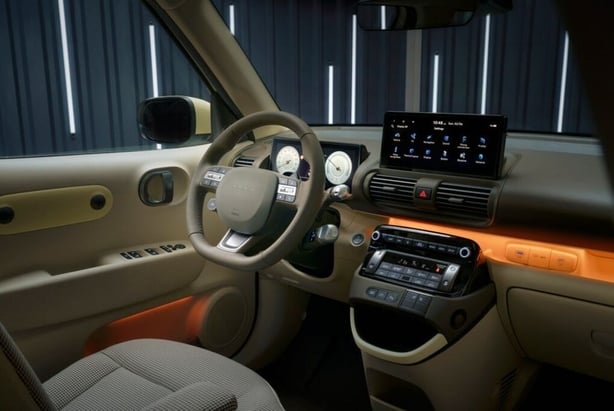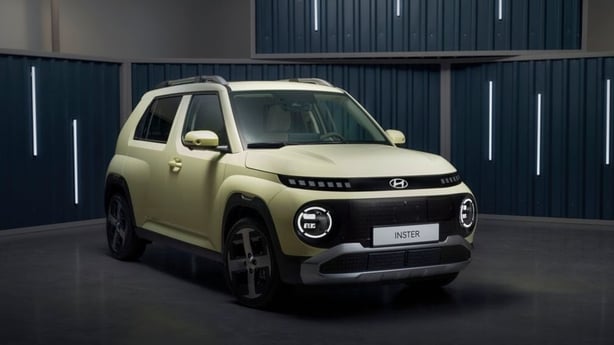To say the arrival of Hyundai's new small EV, the Inster, has surprised the market would be an understatement.
I for one wasn’t expecting an electric car with a starting price of just under €19,000 to be as good as this - especially given that the car is selling in the UK for the equivalent of €28,456 and in Germany for €24,000.
Hyundai Ireland has managed to get quite a deal from its manufacturer with this pricing, and some people in the motor industry are not just mystified, but jealous of the bargain. The Inster has managed to inject a level of competition into the Irish EV market that wasn’t foreseen.
Even the cheapest EV on the market, the Dacia Spring, is only €2,000 less expensive than Hyundai’s offering. But the extra €2,000 for the Inster will get you a lot more quality, a far superior interior and a very good range for the added investment.
There are a number of things that make this car distinctive in a market in which EV’s are often too expensive, deliver far less in terms of range than they promise and are, frankly, dull.

The styling of the Inster - like other Hyundai cars such as the Ioniq 6 - might be a little divisive for some people. Its rather boxy profile is reminiscent of the styling of a Suzuki Ignis but it is far from ugly, just surprisingly different. It’s actually quite cute in many respects, especially with its rounded headlights and front styling.
But it’s the interior that enables the Inster to shine and punch way above its weight. Hyundai has managed to scale down the interior of its bigger models to give this car level of comfort and finish that belies its budget price. Even the steering wheel is from the Ioniq 5.
Just how Hyundai has managed this is a bit of a marvel. The car feels a great deal more spacious than you would expect before you get into it. The boot is a reasonable size too and appropriate for a car of this size.
Having been able to drive it over a reasonably long distance, I felt as a tall driver that the engineers had missed a bit of a trick, however. An extra two inches travel for the driver’s seat would have made a big difference in terms of leg comfort.
Still, the relatively long wheelbase and short overhangs allow for a bright and roomy experience overall.
You get two 10.5" screens for information and entertainment, with the centre screen having a very crisp display, with good graphics.
There is a welcome - a very welcome - row of buttons so you can easily adjust things like heating and and the radio volume, without having to distract yourself by fiddling and poking at a screen when driving.
It’s fun to drive, with pretty well tuned suspension, and it’s an ideal city car. Having said that, it performs well on a longer journey too.

There are two versions of the car: the entry-level Signature, which starts at that €18,995 price point and the Elegance, which costs €21,995. The former has a 42 kWh battery, with a claimed range of 327km and the latter has a 49 kWh battery and a claimed range of 360km.
The entry-level Signature has things like 15" alloy wheels, heated seats and steering wheel, an automatic parking brake and electric folding wing mirrors. You’ll even get a satellite navigation system that’s both functional and attractive on the screen.
Both versions have a good suite of safety equipment as standard, making the price of both as competitive as it gets right now. Apart from the Spring, other near competitors are cars like the Fiat 500 e, which costs €24,995 and the Citroen EC 3, which costs €23,400.
Apart from the battery size, the only main features that distinguish both versions are that the Elegance gets things like a heat pump, which helps consumption in colder weather, a rear sliding bench, 17" alloy wheels, high pixel LED lights front and rear and roof rails. At just under €22,000 it’s also quite a bargain.
I drove the Elegance version and, on starting, it had an indicative available range of 361km. After almost 200km of driving (181.3km to be precise) it still had an indicated range of 136km available. That would give a real-world range of 318km.
This isn’t much of a shortfall given the fact that I did a lot of driving at motorway speeds and in relatively cold weather. Even at higher speeds the energy consumption was coming in at an average of 13.7 kWh per 100km and that’s better than I have achieved in many other electric cars I’ve driven.
Fast charging on both versions of the Inster can be achieved from 10 to 80 per cent in 30 minutes, according to Hyundai.

Hyundai points out that its warranty outstrips the competition - it has unlimited mileage and a five year duration, with an eight year battery guarantee. The Spring, for example, has a three year, 100,000km warranty.
For its price, range and comfort levels the Inster is out on its own and has emerged as the best value EV on the market.
I’d go so far as to suggest that the package the Inster represents might well be a tipping point for those who have been reticent about buying an EV, especially given its dependable range, which should be adequate for many drivers.
While Hyundai has managed to land this car at the price it has, don’t expect the price of both versions to remain as they are for all that long. The company has already indicated as much.
The views expressed here are those of the author and do not represent or reflect the views of RTÉ


